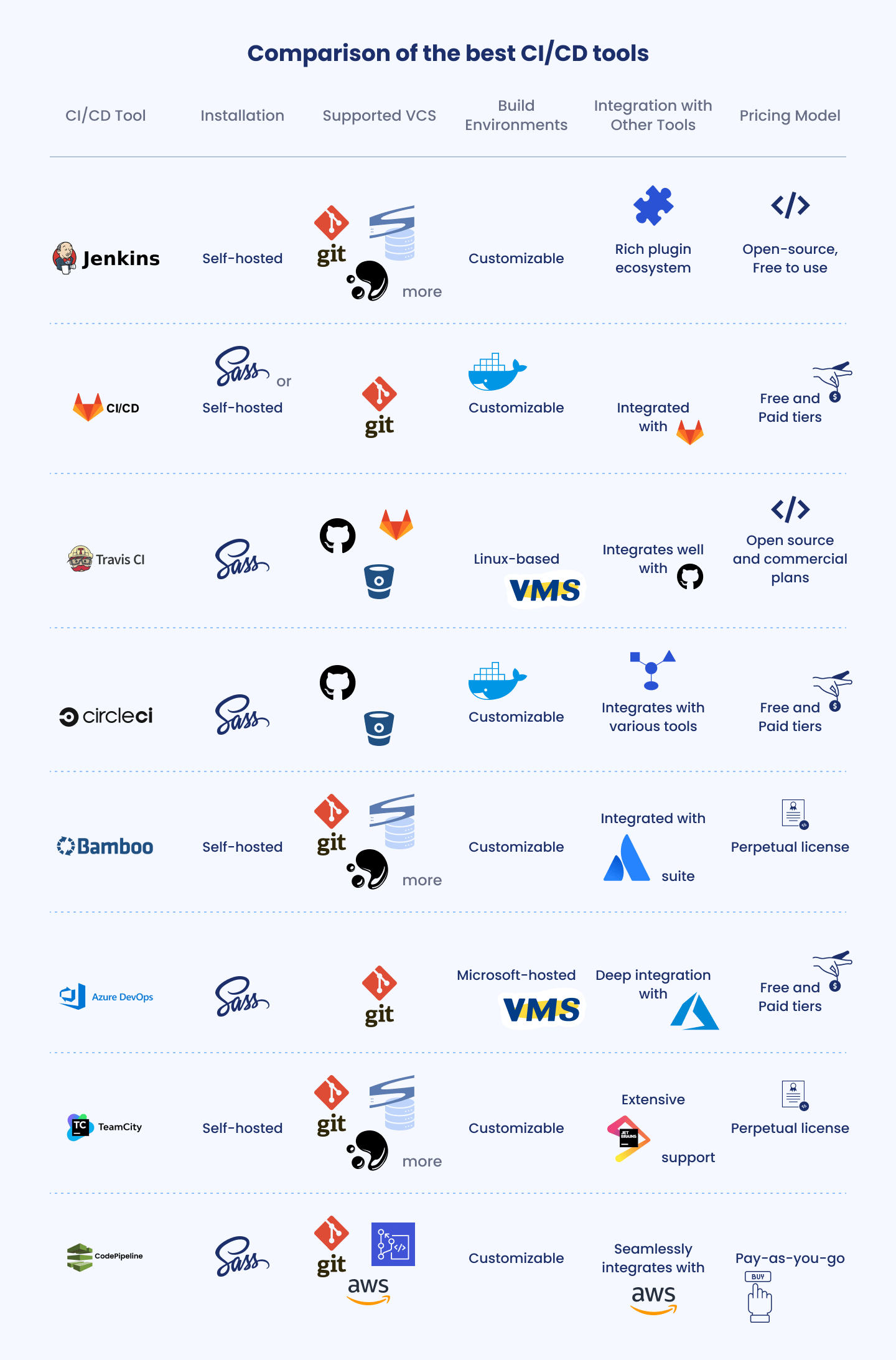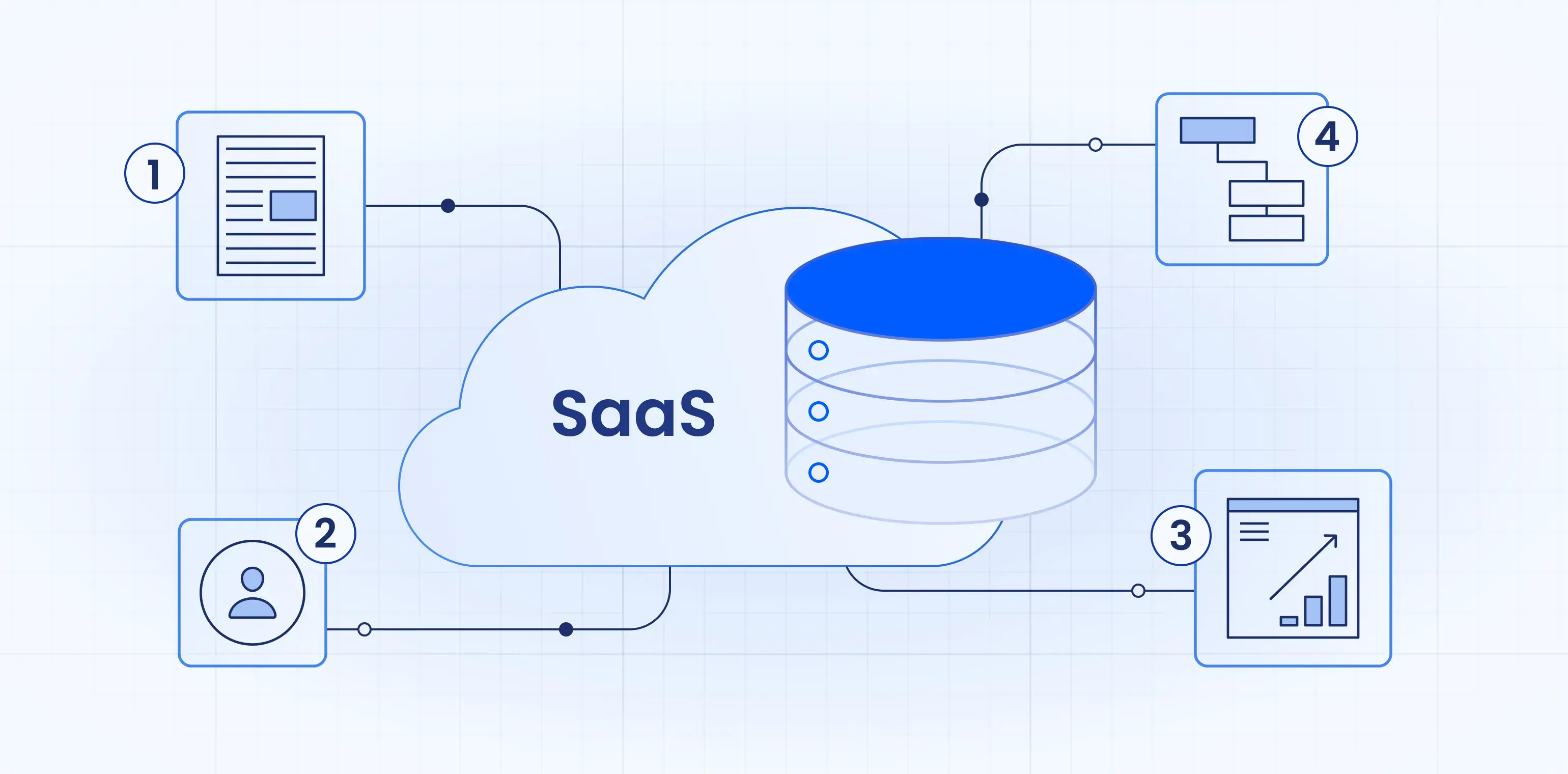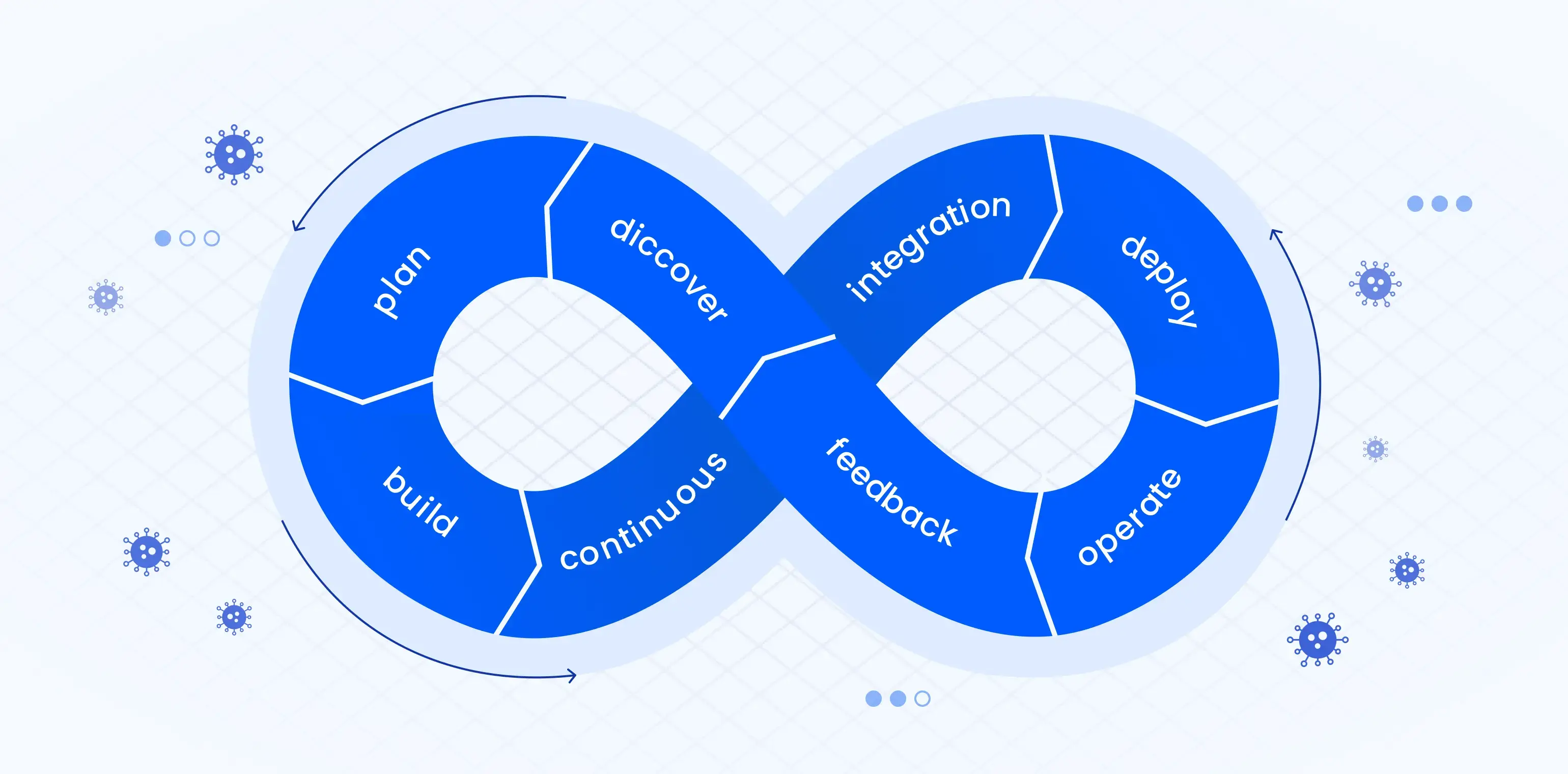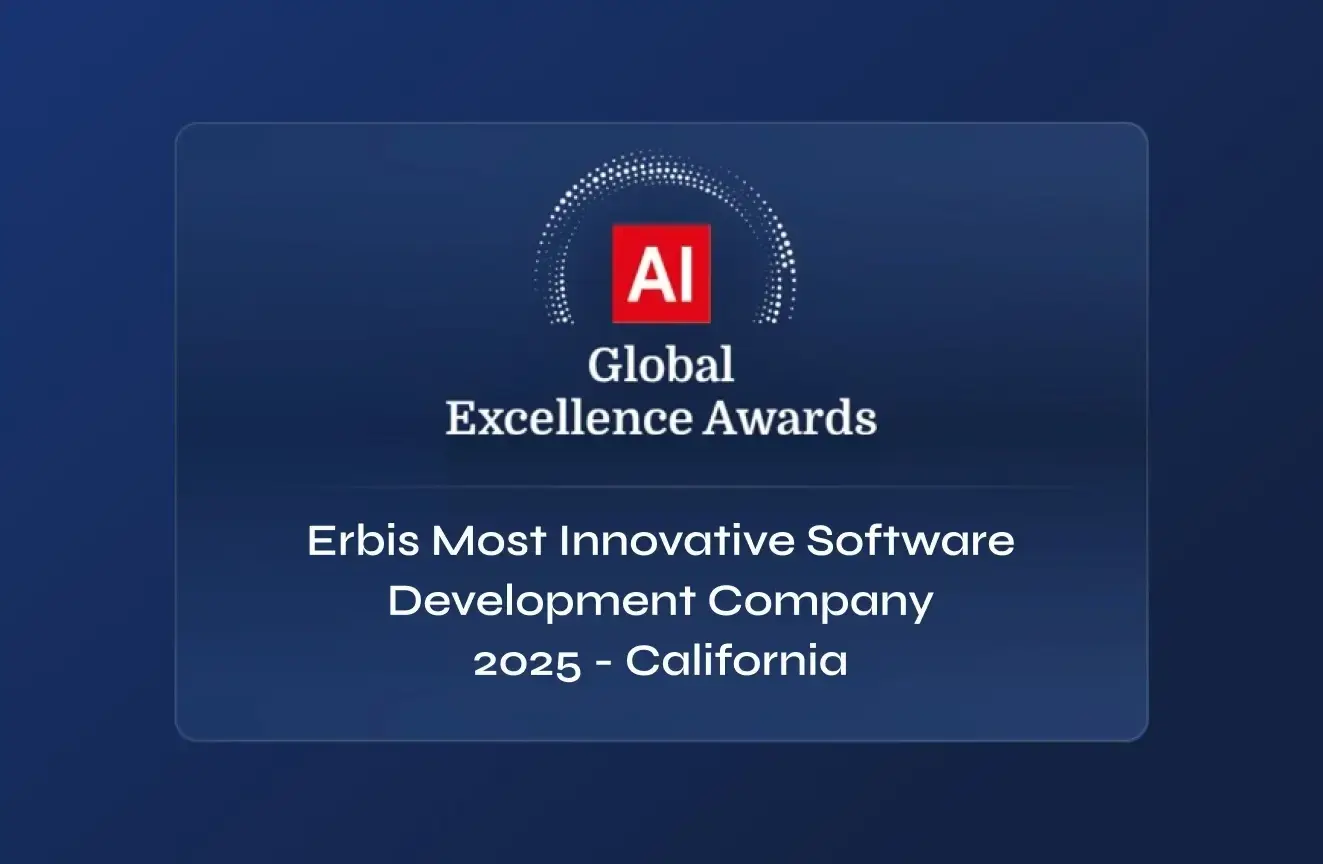Top 8 CI/CD Tools for DevOps: A Comprehensive Review
DevOps practices have become a sort of haut ton in building software development lifecycles (SDLC). DevOps combines development and operational teams and introduces automation into the development, testing, deployment, and release processes. A DevOps engineer accompanies all stages of software creation, from writing code to delivering it to end-users. DevOps also ensures a secure SDLC and, thus, transforms into DevSecOps.
The main goal of a DevOps professional is to create a smooth CI/CD (continuous integration/continuous delivery) process with minimal manual operations. To achieve this, they utilize cutting-edge CI/CD tools and monitor the latest IT trends.
This article will outline the CI/CD tools used by Erbis DevOps engineers. We'll discuss the pros and cons of each instrument and explain how to apply it to improve the software development process.
Jenkins

Jenkins is one of the most popular CI/CD tools, which serves as an automation server that orchestrates tasks and processes in CI/CD workflows. Jenkins is a self-contained Java-powered program, pre-configured for immediate use, and comes with installations available for Windows,
Linux, macOS, and various Unix-like operating systems.
Features
Code repository integration. Jenkins integrates with version control systems like Git, SVN, and others. Developers commit code changes to the repository, triggering Jenkins to initiate the CI/CD pipeline.
Triggering jobs. Jenkins listens for changes in the code repository, and when a new commit is detected, it triggers predefined jobs. Such jobs are sets of instructions that define the tasks Jenkins needs to perform.
Building. The first step in the CI process is building the application. Jenkins pulls the latest code from the repository and compiles the source code into executable artifacts. If the build is successful, it proceeds to the next stage; otherwise, it alerts the team of issues that arise.
Automated testing. Once the build is complete, Jenkins automatically executes a suite of tests, including unit tests, integration tests, etc., to ensure the code changes do not introduce regressions or bugs.
Reporting. Jenkins, like other the best CI/CD tools, generates reports on the test results, code coverage, and other metrics. These reports provide valuable insights into the health and quality of the software.
Pros
Open-source. Jenkins' open-source nature allows for easy customization and integration with numerous plugins, catering to the specific needs of each project.
Ease of use. Jenkins is one of the most loved CI/CD pipeline tools because of its user-friendly interface and intuitive setup process.
Automation efficiency. Jenkins automates repetitive tasks, significantly reducing manual efforts and ensuring faster feedback loops.
Cons
Maintenance overhead. Jenkins requires regular maintenance, including plugin updates and security patches, which can be time-consuming.
Resource intensity. Large-scale deployments may demand significant hardware resources, impacting the overall cost.
Lack of native CI/CD features. While Jenkins excels in CI, it may require additional plugins or scripts to achieve seamless CD.
Pricing
Free. Jenkins is one of the most used CI/CD tools with extensive community support.
Need professional assistance in CI/CD setup?
GitLab CI/CD

GitLab CI/CD comes second in our list of CI/CD tools. It automates the process of building, testing, and deploying the code to various environments. GitLab CI/CD is also tightly integrated with GitLab, making it easier for teams to manage their code, pipelines, and deployments within a single application.
Features
Multi-runner support. GitLab CI/CD supports multiple runners responsible for executing the pipeline jobs. Runners can be shared among projects and can be set up on different platforms, such as Linux, macOS, and Windows.
Parallel and distributed builds. Pipelines in GitLab CI/CD can be configured to run jobs in parallel, which speeds up the overall build and testing process. Distributed builds allow teams to distribute the workload across multiple runners and achieve faster results.
Review apps. GitLab CI/CD enables the creation of temporary environments for each merge request, commonly known as "Review Apps." This feature allows reviewers to test changes in a live environment before they are merged into the main codebase.
Auto DevOps. GitLab CI/CD offers an Auto DevOps feature that automates the setup of pipelines for common use cases, making it easier for developers to get started with CI/CD without extensive configuration.
Integration with Kubernetes. GitLab CI/CD provides native integration with Kubernetes, allowing seamless app deployment to Kubernetes clusters.
Pros
Streamlined development workflow. GitLab CI/CD automates the build, test, and deployment processes, providing a seamless and efficient development workflow.
Diverse integration ecosystem. GitLab CI/CD integrates seamlessly with popular version control systems, issue trackers, container registries, cloud platforms, and more.
Version control integration. GitLab CI/CD is tightly integrated with GitLab version control, which facilitates the automatic triggering of pipelines whenever code changes are pushed.
Cons
Initial setup complexity. Configuring the .gitlab-ci.yml file, setting up runners, and integrating with external tools may require significant effort, particularly for teams new to CI/CD.
Learning curve. Understanding how to structure pipelines, define jobs, and handle artifacts might take some time and practice.
Maintenance overhead. GitLab CI/CD, like many other CI/CD tools, requires regular updates and maintenance. These tasks must be addressed to avoid potential vulnerabilities in the CI/CD pipeline.
Pricing
GitLab.com offers Free, Premium, and Ultimate tiers, and GitLab CI/CD is available in all these tiers.
Travis CI

Number three on the list of most popular CI/CD tools is Travis CI. With the help of Travis CI, developers can build, test, and deploy workflows for software projects. They can also integrate with version control systems and maintain high-quality code.
Features
Extensive language support. Travis CI supports a wide range of programming languages, including but not limited to JavaScript, Python, Ruby, Java, Go, C++, and more. This versatility enables developers to use their preferred language for their projects.
Build matrix. Travis CI allows users to define a build matrix that runs multiple jobs concurrently with different configurations (e.g., different environments or dependencies). This feature is beneficial for testing software across multiple platforms or environments in parallel.
Caching. To speed up the build process, Travis CI provides caching options. Developers can cache dependencies and build artifacts, reducing the time it takes to set up the built environment and execute tests.
Notifications. Travis CI can send notifications about build results via email, Slack, or IRC. This feature enables teams to stay informed about the status of their builds and react quickly to any potential issues.
Customizable environment. Users can customize the build environment on Travis CI, installing specific packages, setting environment variables, and configuring services as needed for their projects.
Pros
Easy integration and setup. The integration with version control platforms is done through a simple .travis.yml file, which allows for quick customization of build and test processes.
Wide language support. Travis CI enables developers to build and test projects written in various languages without additional configuration.
Free for open-source projects. Travis CI offers a free tier for open-source projects hosted on GitHub, allowing developers to use CI/CD capabilities without incurring additional costs for their public repositories.
Cons
Limited parallel builds for Free Tier. The free tier of Travis CI limits the number of parallel builds, which can lead to slower build times. If faster builds are required, upgrading to a paid plan might be necessary.
Dependency on external service. Travis CI is a cloud-based CI/CD tool, meaning it relies on external servers to run builds. While this is convenient for many projects, it can become a concern if internet connectivity or the service itself experiences issues.
Lack of an on-premises option. Unlike some other CI/CD security tools, Travis CI is not available as a self-hosted, on-premises solution. This may be a drawback for organizations with specific security requirements that mandate running CI/CD processes within their own infrastructure.
Pricing
Open source and commercial plans. The open-source version is free for public repositories, while the commercial version provides additional features and is available for private repositories.
CircleCI

CircleCI is another representative of CI/CD automation tools. It automates the process of building, testing, and deployment and supports various programming languages, platforms, and deployment environments.
Features
Docker support. CircleCI has excellent Docker support, allowing developers to create customized build environments with specific dependencies, tools, and settings.
Parallel and distributed builds. CircleCI allows concurrent builds, enabling multiple jobs or workflows to run simultaneously. Parallelization speeds up the overall CI/CD process and helps teams achieve faster feedback on their changes.
Orbs. CircleCI Orbs are reusable configurations that encapsulate complex build and deployment processes. Developers can use community-contributed Orbs or create custom ones to simplify and standardize CI/CD configurations across projects..
Notifications. CircleCI supports various notification channels, such as email, Slack, and others, to keep teams informed about build results and status changes. This ensures efficient communication and quick response to any build-related issues.
Scheduled builds. Developers can run specific jobs or workflows at predetermined times. This feature is useful for periodic testing, backup jobs, or other maintenance activities.
Pros
Ease of use. CircleCI offers a user-friendly interface and straightforward setup, making it easy for developers to use CI/CD.
Docker support. CircleCI's robust Docker support allows developers to create customized build environments and simplifies the management of complex dependencies.
Parallel builds. Concurrent builds speed up the overall CI/CD process, providing faster feedback and reducing the time required for testing and deployment.
Cons
Pricing. Pricing for additional resources or features is relatively high compared to other CI/CD tools.
Resource limitations for Free Tier. Large organizations may need to upgrade to a paid plan or consider alternative CI/CD solutions with more generous free offerings.
Complex configurations. Although CircleCI is relatively easy to get started with, more complex build configurations can become challenging to manage.
Pricing
Flexible pricing model with Free Tier, Performance Plan, and Scale Plan
Bamboo

Bamboo takes a prominent place in the CI/CD tools list. It is a CI/CD server provided by Atlassian and designed to help development teams automate the process of building, testing, and deploying code changes.
Features
Build pipelines. Bamboo allows developers to create complex build pipelines with multiple stages and tasks. These pipelines define the sequence of actions required to build and test the application, ensuring a consistent and repeatable process.
Integration with the Atlassian ecosystem. Bamboo seamlessly integrates with other Atlassian products, such as Jira and Bitbucket. This tight integration enables seamless communication between development, testing, and issue tracking, providing end-to-end visibility in the software development lifecycle.
Remote agent capability. Bamboo supports remote agents, which allows you to distribute builds and tests across multiple machines or environments. This capability helps improve build performance and resource utilization, especially for projects with large codebases or extensive test suites.
Deployment projects. Bamboo offers projects with automated deployments to staging, production, and other environments. This feature ensures that code changes are consistently and reliably deployed to the target environment, reducing the risk of errors during deployment.
Build artifact management. Bamboo allows developers to store and access outputs generated during the build process. Artifacts, such as compiled binaries, documentation, and test reports, can be used in subsequent pipeline stages or shared with other team members for further analysis.
Pros
Robust plugin ecosystem. Bamboo offers a wide range of plugins and integrations available through the Atlassian Marketplace, allowing teams to extend and customize their CI/CD pipelines.
Scalability. Bamboo is known for its ability to scale, making it suitable for projects of various sizes and complexities.
Customizable build environments. Bamboo enables developers to create tailored environments with specific dependencies, configurations, and settings.
Cons
Cost. Bamboo is not available for free, and its licensing costs may be a concern for smaller teams or organizations with limited budgets.
Learning curve. Bamboo can have a steeper learning curve compared to some other DevOps CI/CD tools, especially for teams new to Atlassian's ecosystem or those transitioning from other CI/CD solutions.
Limited third-party integrations. While Bamboo integrates well with Atlassian products, its support for third-party integrations might be more limited compared to other CI and CD tools.
Pricing
Bamboo CI/CD pricing is based on a perpetual license model. Atlassian offers both Server and Data Center deployment options for Bamboo.
Azure DevOps

Azure DevOps occupies an important place in the list of CI/CD pipeline tools. It is a cloud-based Microsoft platform that offers development services to plan, build, test, and deploy applications more efficiently.
Features
Work item tracking. This allows teams to manage and track their development tasks, bugs, and user stories. Work items can be organized into backlogs and boards and provide visibility into the status of each item.
Continuous Integration and Continuous Deployment. This feature ensures that code is continuously integrated and deployed to various environments, reducing manual effort and improving software quality.
Git version control. Azure DevOps provides Git repositories for version control. It supports standard Git workflows, making it easy for developers to work together on code changes and track version history.
Build and release pipelines. Azure DevOps enables teams to create and customize CI/CD pipelines using the YAML-based Azure Pipelines. Developers can define their build and deployment processes, promoting consistency and easy versioning of pipelines.
Test management. Azure DevOps offers test management features allowing teams to plan, create, and execute application tests. It supports manual and automated testing, integration with popular testing frameworks, and provides test result tracking and reporting.
Pros
Comprehensive integration with the Microsoft ecosystem. Azure DevOps seamlessly integrates with other Microsoft tools and services, such as Microsoft Teams, Azure Cloud, and Active Directory.
Scalability and flexibility. Azure DevOps is highly scalable and suitable for projects of various sizes, from small startups to large enterprises.
Azure marketplace extensions. Azure DevOps has a rich ecosystem of extensions available in the Azure Marketplace, providing a wide array of third-party integrations and add-ons.
Cons
Complex setup. Azure DevOps is a feature-rich platform, and while it offers extensive documentation, inexperienced teams may find it challenging.
Limited Git repository size. Unlike some other CI/CD tools, Azure DevOps imposes size limitations on Git repositories, which may be a concern for projects with large or complex codebases.
Cost for larger teams. Organizations with a significant number of users and extensive resource requirements may need to evaluate the pricing model to align with their budget.
Pricing
Azure DevOps offers a flexible pricing model based on the number of users and the features you require. This CI/CD tool provides a range of pricing plans, including free plans for small teams and paid plans for larger teams.
TeamCity

TeamCity is number 7 on the list of the most popular CI/CD tools. It is a CI/CD server by JetBrains designed to help teams deliver software more efficiently and with higher quality.
Features
Build configurations. These allow developers to specify how the code should be built, tested, and deployed. Build configurations can be customized to meet the specific needs of each project, supporting a wide range of build and test processes.
Build agents. TeamCity uses build agents to execute build and test tasks on different machines or environments. Agents can be distributed across multiple servers, allowing for parallel and distributed builds, which speeds up the CI process.
VCS integration. TeamCity integrates seamlessly with various version control systems (VCS), including Git, Mercurial, and Subversion. It automatically triggers builds upon code commits or pull requests, ensuring continuous integration.
Build chains. TeamCity supports build chains, allowing developers to define complex workflows with multiple build configurations chained together. This feature enables teams to create comprehensive and multi-stage CI/CD pipelines.
Build history and reports. TeamCity provides a detailed build history and comprehensive reports, showing the status and results of each build and test. This information helps identify build failures, track progress, and analyze historical data to improve development processes.
Pros
Easy to set up and use. TeamCity is known for its ease of setup and user-friendly interface. It is a great CI/CD tool for beginners and experienced users to configure and manage CI/CD pipelines.
Support for diverse build environments. TeamCity offers excellent support for various build environments, programming languages, and tools, allowing developers to use their preferred tech stack without restrictions.
Excellent plugin ecosystem. TeamCity has a rich ecosystem of plugins contributed by the community, extending its functionality and enabling teams to integrate with additional tools and services seamlessly.
Cons
Licensing costs for large teams. TeamCity is licensed based on the number of build agents, and the licensing costs can become a concern for organizations with a significant number of build agents or users.
Limited built-in reporting and analytics. TeamCity provides some reporting and analytics features; however, their range is less extensive than that of other CI/CD tools.
Self-hosting complexity. Setting up and managing a self-hosted TeamCity instance can be more resource-intensive compared to other cloud-based CI/CD tools. Teams without dedicated IT resources might find this aspect challenging.
Pricing
TeamCity offers a flexible licensing model based on the number of build agents. The pricing is perpetual, meaning you pay a one-time license fee and can use the software indefinitely.
Not sure which CI/CD tools will suit your development process? To get professional DevOps advice
AWS CodePipeline

Last but not least in the list of CI/CD tools is AWS CodePipeline. It enables developers to automate the release process of their applications, making it easier to build, test, and deploy code changes across different environments.
Features
Pipeline creation and orchestration. AWS CodePipeline allows developers to define and customize the entire CI/CD workflow as a pipeline. The pipeline consists of a series of stages, each representing a specific action, such as building, testing, and deploying.
Integration with AWS services. CodePipeline integrates with various AWS services, such as AWS CodeBuild, AWS CodeDeploy, and AWS CodeCommit. This integration enables developers to leverage AWS infrastructure and services to streamline the CI/CD process.
Flexible deployment strategies. CodePipeline supports various deployment strategies, including rolling updates, blue/green deployments, and canary deployments. These strategies allow developers to control the release process and ensure minimal downtime during deployments.
Approval actions. CodePipeline includes manual approval actions that can be inserted at specific pipeline stages. This feature allows teams to introduce manual reviews and approvals before moving to the next stage of the CI/CD pipeline.
Pipeline versioning and history. AWS CodePipeline keeps track of pipeline versions and records pipeline executions. This capability helps developers maintain visibility into changes made to the pipeline over time and facilitates debugging and troubleshooting.
Pros
Seamless integration with AWS Services. AWS CodePipeline integrates with various AWS services, such as AWS CodeBuild, AWS CodeDeploy, and AWS CodeCommit, making it easy to leverage the full capabilities of the AWS ecosystem.
Scalability and reliability. AWS CodePipeline handles projects of different sizes and scales, ensuring smooth execution of CI/CD workflows even for large and complex applications.
Customizability and flexibility. CodePipeline allows developers to create highly customizable CI/CD pipelines with different stages, actions, and deployment strategies, providing the flexibility to tailor the workflow to specific project requirements.
Cons
Limited integration with non-AWS services. While AWS CodePipeline excels in integrating with AWS services, it may have limitations when it comes to integrating with non-AWS CI/CD tools.
Cost for active pipelines. AWS CodePipeline charges based on the number of active pipelines and the number of pipeline executions. This might become a consideration for teams with many active pipelines.
Limited support for multi-cloud environments. AWS CodePipeline is primarily designed to work with AWS services, which means it may have limited out-of-the-box support for multi-cloud environments or deployments to non-AWS platforms.
Pricing
AWS CodePipeline follows a pay-as-you-go pricing model, where you only pay for the resources and executions you use. The pricing is based on the number of active pipelines and pipeline executions.
Best CI/CD tools for DevOps: comparison table

Conclusion
Choosing the right technologies and CI/CD tools is crucial in the development process. Depending on the project's nature and the team's expertise, certain CI/CD DevOps tools may or may not suit you. Given this, it is essential to involve experienced DevOps engineers to automate the development pipeline and establish an efficient CI/CD process.
At Erbis, we have successfully implemented 50+ projects of different scales and complexities. If you are looking for top-notch specialists to help you set up a CI/CD pipeline, don't hesitate to get in touch.
FAQ
Yes, CI/CD tools can be used with different programming languages and frameworks as they are designed to support a wide variety of tech stacks, providing flexibility and automation for diverse development environments.
Yes, CI/CD tools are suitable for both cloud-based and on-premises environments as they offer the flexibility to integrate with various infrastructure setups, allowing teams to automate their development workflows regardless of their hosting preferences.
CI/CD tools enable a high level of automation, ranging from automating code compilation, testing, and deployment processes to orchestrating complex workflows, ultimately facilitating continuous integration and continuous delivery of software with minimal manual intervention.
Yes, CI/CD tools are versatile and can be used for different types of applications, including web, mobile, and microservices, providing automation and efficiency across diverse development projects.
Yes, CI/CD tools can be seamlessly integrated with various cloud platforms and services, allowing teams to leverage the benefits of cloud infrastructure for building, testing, and deploying applications efficiently.













